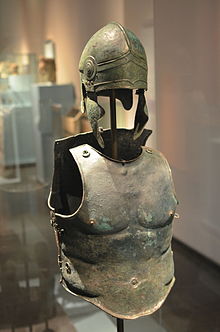
In classical antiquity, the muscle cuirass (Latin: lorica musculata),[a] anatomical cuirass, or heroic cuirass is a type of cuirass made to fit the wearer's torso and designed to mimic an idealized male human physique. It first appears in late Archaic Greece and became widespread throughout the 5th and 4th centuries BC.[1] Originally made from hammered bronze plate, boiled leather also came to be used.[citation needed] It is commonly depicted in Greek and Roman art, where it is worn by generals, emperors, and deities during periods when soldiers used other types.
In Roman sculpture, the muscle cuirass is often highly ornamented with mythological scenes. Archaeological finds of relatively unadorned cuirasses, as well as their depiction by artists in military scenes, indicate that simpler versions were worn in combat situations. The anatomy of muscle cuirasses intended for use might be either realistic or reduced to an abstract design; the fantastically illustrated cuirasses worn by gods and emperors in Roman statues usually incorporate realistic nipples and the navel within the scene depicted.
Cite error: There are <ref group=lower-alpha> tags or {{efn}} templates on this page, but the references will not show without a {{reflist|group=lower-alpha}} template or {{notelist}} template (see the help page).
- ^ M. Treister, "The Theme of Amazonomachy in Late Classical Toreutics: On the Phalerae from Bolshaya Bliznitsa," in Pontus and the Outside World: Studies in Black Sea History, Historiography, and Archaeology (Brill, 2004), p. 205; Charlotte R. Long, The Twelve Gods of Greece and Rome (Brill, 1987), p. 184.